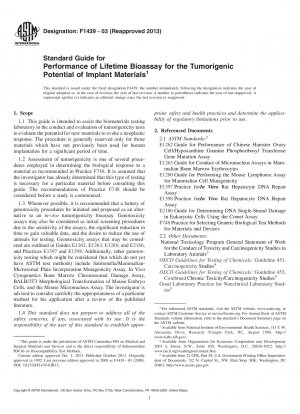ASTM F1439-03(2013)
Standard Guide for Performance of Lifetime Bioassay for the Tumorigenic Potential of Implant Materials
- Standard No.
- ASTM F1439-03(2013)
- Release Date
- 2003
- Published By
- American Society for Testing and Materials (ASTM)
- Status
- Replace By
- ASTM F1439-03(2018)
- Latest
- ASTM F1439-03(2018)
- Scope
4.1 This guide is not intended to specify the exact method of conducting a test for any particular material but only to present some of the criteria that should be considered in method design and possible problems that could lead to misleading results. In the development of the actual test protocol, it is recommended that recognized tumorigenesis bioassay procedures be consulted.
4.2 The recommendations given in this guide may not be appropriate for all applications or types of implant materials. These recommendations should be utilized by experienced testing personnel in conjunction with other pertinent information and the requirements of the specific material application.
1.1 This guide is intended to assist the biomaterials testing laboratory in the conduct and evaluation of tumorigenicity tests to evaluate the potential for new materials to evoke a neoplastic response. The procedure is generally reserved only for those materials which have not previously been used for human implantation for a significant period of time.
1.2 Assessment of tumorigenicity is one of several procedures employed in determining the biological response to a material as recommended in Practice F748. It is assumed that the investigator has already determined that this type of testing is necessary for a particular material before consulting this guide. The recommendations of Practice F748 should be considered before a study is commenced.
1.3 Whenever possible, it is recommended that a battery of genotoxicity procedures be initiated and proposed as an alternative to an in-vivo tumorigenicity bioassay. Genotoxicity assays may also be considered as initial screening procedures due to the sensitivity of the assays, the significant reduction in time to gain valuable data, and the desire to reduce the use of animals for testing. Genotoxicity assays that may be considered are outlined in Guides E1262, E1263, E1280, and E2186, and Practices E1397 and E1398. Additionally, other genotoxicity testing which might be considered (but which do not yet have ASTM test methods) include Salmonella/Mammalian-Microsomal Plate Incorporation Mutagenicity Assay, In Vivo Cytogenetics Bone Marrow Chromosomal Damage Assay, BALB/3T3 Morphological Transformation of Mouse Embryo Cells, and the Mouse Micronucleus Assay. The investigator is advised to consider carefully the appropriateness of a particular method for his application after a review of the published literature.
1.4 This standard does not purport to address all of the safety concerns, if any, associated with its use. It is the responsibility of the user of this standard to establish appropriate safety and health practices and determine the applicability of regulatory limitations prior to use.
ASTM F1439-03(2013) Referenced Document
- ASTM E1262 Standard Guide for Performance of Chinese Hamster Ovary Cell/Hypoxanthine Guanine Phosphoribosyl Transferase Gene Mutation Assay
- ASTM E1263 Standard Guide for Conduct of Micronucleus Assays in Mammalian Bone Marrow Erythrocytes
- ASTM E1280 Standard Guide for Performing the Mouse Lymphoma Assay for Mammalian Cell Mutagenicity
- ASTM E1397 Standard Practice for In Vitro Rat Hepatocyte DNA Repair Assay
- ASTM E1398 Standard Practice for In Vivo Rat Hepatocyte DNA Repair Assay
- ASTM E2186 Standard Guide for Determining DNA Single-Strand Damage in Eukaryotic Cells Using the Comet Assay
- ASTM F748 Standard Practice for Selecting Generic Biological Test Methods for Materials and Devices
ASTM F1439-03(2013) history
- 2018 ASTM F1439-03(2018) Standard Guide for Performance of Lifetime Bioassay for the Tumorigenic Potential of Implant Materials
- 2003 ASTM F1439-03(2013) Standard Guide for Performance of Lifetime Bioassay for the Tumorigenic Potential of Implant Materials
- 2003 ASTM F1439-03(2008) Standard Guide for Performance of Lifetime Bioassay for the Tumorigenic Potential of Implant Materials
- 2003 ASTM F1439-03 Standard Guide for Performance of Lifetime Bioassay for the Tumorigenic Potential of Implant Materials
- 2002 ASTM F1439-02 Standard Guide for Performance of Lifetime Bioassay for the Tumorigenic Potential of Implant Materials
- 1992 ASTM F1439-92(1996) Standard Guide for Performance of Lifetime Bioassay for the Tumorigenic Potential of Implant Materials
